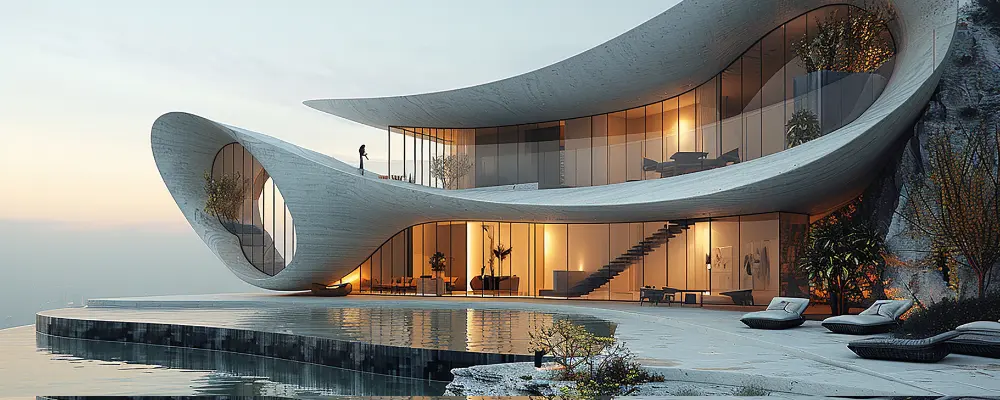“Mid-century modern style” is a phrase that we often hear in the AEC (Architecture, Engineering and Construction) industry, most commonly in the interior design field. It is a style that regularly creates waves of trend that inspire designers and home-owners alike. Read on to learn more about this style.
What Is Mid-century Modern (MCM) Architecture?
It is an architectural style that emerged during the middle of the 20th century, and was predominantly influenced by Modernist architecture, which rose to prominence during the early 20th century. Fostered by positive sentiments in the aftermath of the Second World War, this style experimented with newly developed materials such as steel, glass and concrete.
How Did Mid-century Modern Architecture Evolve?
Late 19th century and early 20th century architecture witnessed the birth and dominance of the Art Deco and Arts & Crafts movements, largely as a form of protest against mechanical buildings after the Industrial Revolution. These movements incorporated highly decorative and ornamental built forms.
Modern architecture, in turn, evolved to bring back simpler forms, revolting against ornamentation. Greatly influenced by Louis Sullivan’s famous words— “Form follows function”—this style sought a cleaner approach to architecture. The Museum of Modern Art’s (MoMa) exhibition in 1932 showcasing “International Style”, called for the development of a ‘machine aesthetic’ with clean lines and the removal of ornamentation on buildings. Featuring works of prominent architectural leaders of the movement such as Walter Gropius, Le Corbusier, Frank Lloyd Wright and Mies van der Rohe, the exhibition led to a paradigm shift to modern styles of design.
What Were the Features of Mid-century Modern Architecture?
MCM architecture featured a few prominent characteristics that all proponents of the style strictly adhered to. These features dominantly distinguished it from other common styles of the era.
- Open Floor Plans
Minimal interior partitions were created. This resulted in visually interconnected, seemingly larger spaces with flexible usage possibilities.
- Clean Lines
The use of sharp, straight, angular lines in elevation and planning resulted in flat roofs. Curvilinear and organic forms were generally not used.
- Functionality
Aesthetic considerations took a backseat as more prominence was given to functionality. Simple, geometric forms emphasised that these structures were more user-centric.
- Material Usage
Newer materials like steel and concrete were used to create framed structures. This enabled the extensive usage of glass to create large floor-to-ceiling windows that bridged the gap between indoor and outdoor spaces.
- Minimalism
Interiors consisted of sparse furniture with minimal clutter. Muted or earthy hues with occasional pops of colour were used.
What Is The Difference Between Modern, Mid-Century Modern And Contemporary Architecture?
MCM architecture can be incorporated under the broader category of modern architecture. Modern architecture also encompasses other styles such as the ‘International Style’ and Frank Lloyd Wright’s ‘Prairie style’. It was significantly noticed from the early 1920s to the late 1970s, while MCM style was predominantly expressed from 1945 to 1969. MCM architecture was heavily influenced by the Bauhaus style in Germany (also a part of Modern style), owing to soldiers returning to America after the Second World War. Although largely similar to the Modern style, MCM architecture allowed for the use of a few accented colours as highlights, while still maintaining the principle of simplicity.
Contemporary architecture, on the other hand, varies substantially from these two styles. Not encompassing any particular period of time, this style is constantly evolving and can only be defined as the current style of architecture dominant at any time. Following similar principles of open plans and functionality over aesthetics, Contemporary architecture can be said to be derivative of Modern architecture. However, it often features organic forms and darker colours, while not necessarily adhering to minimalism. Subtle ornamentation can also be observed.
Which Buildings Have Been Built in This Style?
Although the style originated in Europe, MCM style was majorly witnessed in the USA, especially in homes in the state of California and larger buildings in New York City. A few prominent architects advocating the style were Richard Neutra, Eero Saarinen, Ludwig Mies van der Rohe and Alvar Aalto.
Farnsworth House
This house designed by Mies van der Rohe, is one of the most well-known examples of the style. Built as a weekend retreat, the house features expansive glass windows offering panoramic views of the surrounding landscape, while its rectilinear form is emphasised with strong horizontal lines of the cantilevered floor and roof slabs.
Glass House
Philip Johnson’s Glass House also embodied MCM principles. A steel framework with glass panels functioning as walls, made up the structure. A cleverly designed cylindrical brick structure camouflages the bathroom in the open floor plan.
Eichler Homes
Real estate developer Joseph Eichler was another major contributor to the popularity of the style, with his company Eichler Homes building more than 10,000 MCM houses in California, USA from 1949 to 1966. These were inspired by the designs of architect Frank Lloyd Wright and brought modern design to the masses.
Mid-century Modern Architecture Today
MCM is a term used to define an architectural style dominant strictly between 1945 and 1969. However, today’s architecture is heavily influenced by this style, even if the term itself cannot be used to describe it. Although the style was prominently witnessed only in the USA and parts of Europe, globalisation in the 1990s led to significant inspiration being derived from this style throughout the world, including India.
Functional, simple forms combined with new-age technologies, are enabling innovations in architecture that are sparked by the original MCM style. Numerous interior designers are also currently favouring cosy furniture, warm interiors with subtle highlights and small pops of colour to brighten up spaces. Offering a range of potential for reinterpretation by current designers, MCM seems to be a style that will not stop trending anytime soon.

